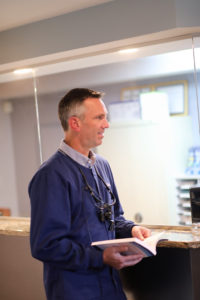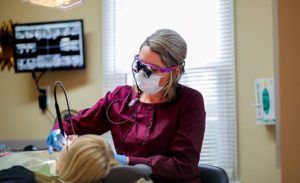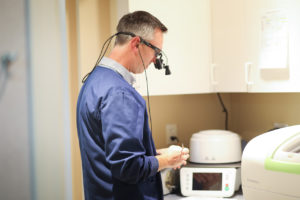Can Having Nightmares Be a Symptom of Sleep Apnea?
September 26, 2023
 Sleep apnea can have many side effects that you may not be aware of. One example is the impact it can have on your dreams. Some people with sleep apnea find that they don’t dream at all, but others might start experiencing particularly vivid nightmares. Your dentist is here to explain more about the relationship between sleep apnea and nightmares – as well as what you can do to improve your dreams.
Sleep apnea can have many side effects that you may not be aware of. One example is the impact it can have on your dreams. Some people with sleep apnea find that they don’t dream at all, but others might start experiencing particularly vivid nightmares. Your dentist is here to explain more about the relationship between sleep apnea and nightmares – as well as what you can do to improve your dreams.
OTHER OPINIONS
September 25, 2023
 It is not uncommon to get a second opinion, or a second or third quote for things like car repairs and home improvements. When it comes to our health, it usually depends on the nature of the issue. More complex issues in medicine, such as a diagnosis of cancer, an unknown diagnosis, or other major medical issues in which we have to make decisions about significant treatment, tend to stimulate people to get more than one opinion. In dentistry, it seems that the incidence of second opinions is not as great.
It is not uncommon to get a second opinion, or a second or third quote for things like car repairs and home improvements. When it comes to our health, it usually depends on the nature of the issue. More complex issues in medicine, such as a diagnosis of cancer, an unknown diagnosis, or other major medical issues in which we have to make decisions about significant treatment, tend to stimulate people to get more than one opinion. In dentistry, it seems that the incidence of second opinions is not as great.
Routine dental care is generally not that complicated. There are many different ways to do the simplest things in dentistry. The method is a function of the dentist’s beliefs and training. It is relatively uncommon for a patient to get a second opinion for this type of maintenance dental care. Although there is some subjectivity as to what different dentists might deem as “needing” to be done, patients usually base their decision on their perceived need. This perception of need comes from the dentist’s ability to communicate the reasons for treatment.
The patient’s trust in their provider is a big factor. If a patient trusts and genuinely likes their dentist, they may not necessarily do or want to do what the dentist wants them to, but they are comfortable enough to make the decision on treatment. It is when there is a lack of trust, for one reason or another, that patients tend to venture out for another opinion. This lack of trust usually stems from a personality conflict or the inability of the dentist to properly communicate with the patient effectively.
Even when there are more complex dental issues, it is my feeling that patients base the need for another opinion on lack of trust. Another important factor is that the patient is given choices. Patients always have the right to choose what treatment they feel is right for themselves. If choices are given and the treatment is properly communicated to the patient, they have the ability to decide in what direction to proceed.
If a dentist properly communicates the need for treatment and the patient decides to do nothing, it is the patient’s choice. It is when treatment is properly presented and it aligns with the patient’s perception of need or desire, that the patient moves forward with treatment.
Fees tend to be a less common reason for patients to seek another opinion. Fees for treatment can definitely vary. The problem with seeking treatment based on fees is that the same treatment in two different offices with different fees can also vary in the level of expertise and precision in which it is done. There are many factors.
A higher fee does not always mean a higher quality product. Fees are generally based on the time involved, the materials used, and the perceived expertise of the provider. Be cautious when seeking treatment based on fees. The fee for treatment should definitely be considered, but the entire treatment presentation and the way in which it is communicated should be used to determine your decision.
Dr. St. Clair maintains a private dental practice in Rowley dedicated to health-centered family dentistry. He has a special interest in treating snoring, sleep apnea and TMJ problems. If there are certain topics you would like to see written about or questions you have please email them to him at jpstclair@stclairdmd.com
THE DAILY GRIND
September 18, 2023
Studies have shown a link between teeth grinding, clenching and headaches. There are also links to people who have sleep breathing disorders, and those who take serotonin uptake inhibitors (SSRI). Some brand names of these drugs are Celexa, Lexapro, Prozac, Paxil and Zoloft. Many people grind and clench their teeth for many different reasons – let’s not forget STRESS!
For people who grind or clench, the muscles that open and close the jaw can become painful from overuse, causing a range of symptoms from tension to migraine headaches to jaw joint (TMJ) problems to tooth pain. Here is a simple test – look at your tongue in the mirror without sticking it out. Are the borders smooth? If they are ridged, you are probably doing something outside of normal function.
Bruxing (grinding) and clenching teeth is defined as abnormal tooth contact (parafunction). Ordinarily, teeth should only be in contact while eating and swallowing, which is about 10 to 15 minutes on a daily basis. People who grind or clench their teeth during the day, or while sleeping, can have their teeth in contact for as much as six hours a day or more. Researchers say that one night of grinding is equivalent to 80 days of normal wear. Read that last sentence again.
Clenching can be just as bad, and in some cases, worse than grinding. The average person puts about 200 lbs. of force on back molars during function, but a person who clenches can put up to 1000 lbs. on the molars. This is a lot of force for the teeth to withstand. Fractured teeth are seen on a regular basis in dental offices due to clenching. Typically, a person will come in saying that their tooth broke while they were eating something soft. While that may be the case, often times clenching and/or grinding has weakened the tooth prior to it breaking.
The American Dental Association estimates that 95 % of the American population suffers from a grinding or clenching problem at some point in their lives. Some people do so much damage over time that they need a lot of dentistry to restore their teeth back to normal function. The key is early diagnosis and treatment.
Many patients do not realize, and some refuse to accept the fact that there is a problem. The reason for this is because many, if not most, do not have symptoms. The masticatory system is a very adaptive and forgiving system. Some even think their symptoms are just normal. However, if a problem is identified, accepted, and treated, it can help prevent numerous potential issues down the road.
Therefore, successful therapy starts with acceptance of the pathology present. In addition to behavior modification, nighttime bite splints can be very effective. They should be worn every night, not just when it “seems” like you have been grinding or clenching. It’s like wearing a knee brace. You wear the brace to support the knee to help prevent more injury.
Some patients require daytime splints because their issues are affecting them during the day, and a “night” guard might not be enough. Over-the-counter appliances are typically not recommended for a variety of reasons.
Ask your dentist whether you have any of the signs associated with grinding or clenching, and especially talk to your dentist if you have any symptoms. If the reason can be identified as to why this happening, it will direct the provider to offering the best solution for your specific situation.
One last thought: Read the first paragraph over. In most people, there is a reason for the grinding and/or clenching. There is a lot of interconnectedness between sleep and other issues. Sometimes, if you fix one thing, other things go away.
Dr. St. Clair maintains a private dental practice in Rowley dedicated to health-centered family dentistry. He has a special interest in treating snoring, sleep apnea and TMJ problems. If there are certain topics you would like to see written about or questions you have please email them to him at 
DENTAL SEALANTS
September 11, 2023
 If you have kids, and you take them to the dentist, I am sure you have heard about sealants. Many, if not most dentists recommend dental sealants.
If you have kids, and you take them to the dentist, I am sure you have heard about sealants. Many, if not most dentists recommend dental sealants.
A dental sealant is a flowable resin, generally placed on permanent 6 and 12-year molars. It is placed in the grooves on the top of the teeth. Its purpose is to help prevent decay from forming in this area, which is the most common place for dental decay to occur. It does nothing in the prevention of decay between teeth, or on any of the other 20 teeth in the mouth – although the molars are generally the first teeth to decay.
Make sense so far? Now for the controversy. In my opinion, sealants have a very limited application. Let me take a step back and give you some information to help you see where I am coming from.
There are actually many different techniques to place sealants. The way we are taught in school, and the way most dentists determine if sealants are recommended, is how deep the grooves in the tooth are. Sealants are placed if that little sharp tool (dental explorer) doesn’t stick in the tooth. The surface of the tooth is cleaned (to the best of the operator’s ability) and the sealant is flowed into the grooves of the tooth and cured with an ultraviolet light.
Problem is, that dental explorer is not very accurate – about 57% according to studies I have seen. Detection shoots to over 90% accuracy with the aid of a laser. This type of laser sends a beam of light into the top of the tooth and measures density of tooth structure.
Are there teeth that get sealed that have decay? Yes. However, according to studies, sealing over minimal decay is clinically acceptable. These studies say that the sealant can actually stop or prevent the decay from progressing. Would you want that in your mouth? I wouldn’t.
But that’s not even the main problem. Once that sealant is placed, the laser detection tool is ineffective. You then have to rely on x-ray detection, which is also not very accurate, unless the decay is moderately large. I cannot tell you how many teeth I have done deep fillings on that had clinically acceptable sealants in place.
So, how does the decay get under the sealant? It was either there to begin with and grew, or the “seal” leaked. ALL dental restorations (some less than others) have a microscopic gap between the restoration and the tooth that is constantly exposed to the oral environment. Over time, that gap becomes bigger, allowing bacteria in, which may potentially cause decay. So, my position is, why would you place a “restoration” on a seemingly healthy tooth?
A healthy diet, good home care, and regular professional care are the keys to dental decay prevention. So, do sealants prevent decay? They aid in not getting stuff stuck in the grooves of teeth which can cause decay, but they do not guarantee you won’t get decay.
The technique used to place the sealant is crucial to its success. Having said that, I would rather have a healthy tooth remain restoration-free, and be able to be monitor it with a laser. If decay is detected early with the laser, the tooth can have a very conservative tooth-colored restoration. This can then be monitored clinically and by x-ray.
So, will I place sealants? Rarely. If I do, it’s only after a discussion with the child’s parents about the things discussed above.
Dr. St. Clair maintains a private dental practice in Rowley dedicated to health-centered family dentistry. He has a special interest in treating snoring, sleep apnea and TMJ problems. If there are certain topics you would like to see written about or questions you have please email them to him at jpstclair@stclairdmd.com
“IT’S JUST A CLEANING”
September 9, 2023
 This is a phrase we hear far too frequently when patients call to cancel or change their dental hygiene appointments. When the patient is told that there are no open hygiene appointments for 4-6 months, the response is often, “Oh, that’s okay, it’s just a cleaning.” This lack of concern is only partly to blame on the patient; most of the accountability falls in the lap of the dental team.
This is a phrase we hear far too frequently when patients call to cancel or change their dental hygiene appointments. When the patient is told that there are no open hygiene appointments for 4-6 months, the response is often, “Oh, that’s okay, it’s just a cleaning.” This lack of concern is only partly to blame on the patient; most of the accountability falls in the lap of the dental team.
If you read this column with any frequency, I am sure you have seen me report that 75% of the population has some form of periodontal (gum) disease. I’m sure you have also read that periodontal disease has been linked to heart disease, stroke, pre-term, low birth-weight babies, diabetes, and possibly even some types of cancer. The problem is the dental team is not discussing this enough with their patients.
Here’s the way I see it: If a patient has made the decision to seek the services of a dental office, we must assume that the reason is based on wanting to improve and/or maintain their dental health. If that’s not the reason you go to the dentist, what is? Patients will often say during an exam, “Please don’t find anything.” Our response may be, “Well then, I better not look.” Assuming the reason for going to a dental office is to improve and/or maintain dental health as part of overall health, it is the obligation of the dental team to “find stuff” if it’s there, communicate that with the patient, and have a conversation about whether any steps should be taken.
For example, based on your level of periodontal health, there are different levels of frequency recommended for hygiene visits. The majority of patients should be seen every 6 months. Some are lucky enough to have yearly visits recommended to them. For others, every 3 or 4 months is recommended. This frequency is determined by your dental team to maintain your dental health. Regardless, if you put off your routine care by 1, 2 or even 6 months, that is a lot of time to have bacterial growth accumulate and put your body into a defensive mode due to increased inflammation. This brings me back to the reason you have chosen to be an active dental patient.
Remember, gum disease is not only bad because it makes your breath stink and your teeth fall out; it is bad for you systemically because of chronic inflammation. You may very well not notice an increase in inflammation, but your body does. There are measurable indicators of this.
If your goal is optimal health, routine maintenance is essential. I tell my team all the time that we must continue to educate the people who put their trust in us to maintain their dental health.
Depending on your car, there is a recommended maintenance schedule. If you ignore the recommended maintenance, only bad things can happen. You may be able to “stretch it out” a little, but must understand there are risks associated with that decision. If you knew how bad chronic inflammation really was for you, you would want to be seen more frequently than you are.
There are obviously valid reasons why patients need to change an appointment. Most dental offices understand that. It is the frequency, attitude (It’s just a cleaning), and lack of commitment that causes both disruption within the dental office and discontinuity of care.
Dr. St. Clair maintains a private dental practice in Rowley dedicated to health-centered family dentistry. He has a special interest in treating snoring, sleep apnea and TMJ problems. If there are certain topics you would like to see written about or questions you have please email them to him at jpstclair@stclairdmd.com
TECHNOLOGY: NOT GOING AWAY
September 6, 2023
 I’m sure we all agree that keeping up with technology is not easy. From computers to cell phones to cars, and everything in between, changes take place at lightning speed. No matter what we buy, there is always something right around the corner, or already there, that is better.
I’m sure we all agree that keeping up with technology is not easy. From computers to cell phones to cars, and everything in between, changes take place at lightning speed. No matter what we buy, there is always something right around the corner, or already there, that is better.
I purchased a digital x-ray system back in January of 2008 to replace film and chemicals to develop. By June of the same year, the same company came out with a smaller, thinner sensor. This didn’t make mine obsolete, but my $10,000 investment made six months before could now be purchased for half the price. I thought I was “jumping in” at the right time.
As with most, if not all industries, technology is sweeping the dental field. We are digitizing everything. Offices that are not already “paperless” are moving in that direction. Automated systems for appointment confirmation via text or email, scheduling appointments, paying bills online, filling out online forms, and digital patient charts have been commonplace in dental offices for a while.
Digital radiology is transforming the way we treatment plan and deliver services such as dental implants. This 3-Dimensional technology allows accurate evaluation of biological structures to provide almost pinpoint placement of dental implants that may not have been able to be done using traditional methods. Notice I said “almost” pinpoint accuracy. It’s still not perfect, but it keeps getting better and better.
You may be aware that some dental offices can make crowns chairside without the use of gooey impression materials or the need of a dental laboratory. This technology has been around for over 25 years. The first generation of this technology was pretty cool back in the day, but delivered less than stellar results. Today, it is safe to say, this technology has greatly improved, continues to get better, and is not going away.
While the technology has gotten significantly better, there are still limitations. Currently, this technology uses a reduction method to fabricate restorations. This means that the restoration is milled from a solid block of material. The material choices are somewhat limited but getting better. What’s next? Maybe 3-D printing of whatever material you would like to use.
I read an article recently about 3-D printing technology where the CEO of this particular company working on dental applications said, “If 3D printing hopes to break out of the prototyping niche it has been trapped in for decades, we need to find a disruptive technology that attacks the problem from a fresh perspective.” I think this technology will be a game-changer.
I have always struggled with when to “jump-in” with certain technologies. It’s not an easy decision. The high cost, the learning curve, and knowing there is always something better right around the corner have been the barriers for me. The more I read about what is on the horizon, the more I want to wait for the “next best thing.”
Dentistry is moving fast forward in technological advances. However, two things come to mind about technology and dentistry. The first, is to keep in mind that sometimes the best option may be an older model. For example, gold is still used in dentistry, and definitely has a place in certain circumstances. The second thing, is that someone has to pay for all this advanced dentistry, and the dental insurance companies haven’t changed their model since the 1970’s. Many insurance companies will pay for more of your filling if get a “silver” one than a tooth-colored one.
We not only need to find “disruptive technology” to help prevent dental disease and treat it earlier and better, we need to have a disruptive revolution of dental insurance.
Dr. St. Clair maintains a private dental practice in Rowley dedicated to health-centered family dentistry. He has a special interest in treating snoring, sleep apnea and TMJ problems. If there are certain topics you would like to see written about or questions you have please email them to him at jpstclair@stclairdmd.com







